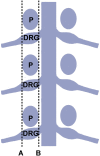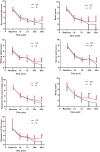Comparison of two distinct needle tip positions in pulsed radiofrequency for herpes zoster-related pain
- PMID: 36880287
- PMCID: PMC10324345
- DOI: 10.1111/cns.14146
Comparison of two distinct needle tip positions in pulsed radiofrequency for herpes zoster-related pain
Abstract
Background: Herpes zoster (HZ)-related pain, characterized by chronic and persistent pain with a dermatomal distribution, is a relatively common complication of HZ. Pulsed radiofrequency (PRF) can effectively relieve HZ-related pain. There is no study on the effect of the needle tip position in patients with HZ for PRF treatment. This prospective study was conducted to compare two distinct needle tip positions in PRF for HZ-related pain.
Methods: Seventy-one patients suffering from HZ-related pain were enrolled in this study. According to the dorsal root ganglion (DRG) position and needle tip position, patients were randomly allocated to the IP group (group inside of the pedicle, n = 36) and OP group (group outside of the pedicle, n = 35). Quality of life and pain control were evaluated with the visual analog scale (VAS) and activities of daily living questionnaires (including 7 items: general activity, mood, walking ability, normal work, relations with other people, sleep, and enjoyment of life), which were administered before therapy and at intervals of 1, 7, 30, and 90 days after therapy.
Results: Before therapy, the mean pain score was found to be 6.03 ± 0.45 in the IP group and 6.00 ± 0.65 in the OP group (p = 0.555). No significant differences were found when the two groups were compared at 1 and 7 days after therapy (p > 0.05). But, the pain score was significantly lower in the IP group at 30 days (1.78 ± 1.31 vs. 2.77 ± 1.31, p = 0.006) and 90 days of follow-up (1.29 ± 1.19 vs. 2.15 ± 1.74, p = 0.041). Significant differences between the two groups in terms of general activity (2.39 ± 0.87 vs. 2.86 ± 0.77, p = 0.035), mood (1.97 ± 1.65 vs. 2.86 ± 1.50, p = 0.021), relations with other people (1.94 ± 0.92 vs. 2.51 ± 1.22, p = 0.037), sleep (1.64 ± 1.44 vs. 2.97 ± 1.44, p < 0.001), and enjoyment of life (1.58 ± 1.11 vs. 2.43 ± 1.33, p = 0.004) were detected after the 30-day follow-up. In addition, scores for the activities of daily living were significantly lower in the IP group than that in the OP group at 90 days after therapy (p < 0.05).
Conclusion: The needle tip position had an influence on the PRF treatment in patients with HZ-related pain. Positioning the needle tip in the area between the medial and lateral edges of adjacent pedicles offered good pain relief and improved quality of life in HZ patients.
Keywords: DRG position; herpes zoster; needle tip position; pulsed radiofrequency.
© 2023 The Authors. CNS Neuroscience & Therapeutics published by John Wiley & Sons Ltd.
Conflict of interest statement
The authors have no funding and conflicts of interest to disclose.
Figures





Similar articles
-
High-voltage, Long-duration Pulsed Radiofrequency to the Dorsal Root Ganglion Provides Improved Pain Relief for Herpes Zoster Neuralgia in the Subacute Stage.Pain Physician. 2023 May;26(3):E155-E162. Pain Physician. 2023. PMID: 37192238
-
Pulsed Radiofrequency to the Dorsal Root Ganglion in Acute Herpes Zoster and Postherpetic Neuralgia.Pain Physician. 2017 Mar;20(3):E411-E418. Pain Physician. 2017. PMID: 28339440
-
Efficacy of Ultrasound-Guided Transverse Abdominal Plane Block for Residual Pain After Pulsed Radiofrequency in Abdominal Acute/Subacute Herpes Zoster-Related Pain.J Ultrasound Med. 2025 Apr;44(4):667-679. doi: 10.1002/jum.16626. Epub 2024 Dec 6. J Ultrasound Med. 2025. PMID: 39641429
-
Comparing the efficacy and safety of short-term spinal cord stimulation and pulsed radiofrequency for zoster-related pain: A systematic review and meta-analysis.Medicine (Baltimore). 2022 Mar 18;101(11):e29073. doi: 10.1097/MD.0000000000029073. Medicine (Baltimore). 2022. PMID: 35356934 Free PMC article.
-
Efficacy of Pulsed Radiofrequency in Herpetic Neuralgia: A Meta-Analysis of Randomized Controlled Trials.Clin J Pain. 2020 Nov;36(11):887-895. doi: 10.1097/AJP.0000000000000867. Clin J Pain. 2020. PMID: 32701526
References
Publication types
MeSH terms
LinkOut - more resources
Full Text Sources
Medical
Miscellaneous

